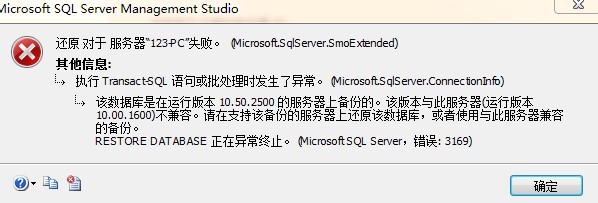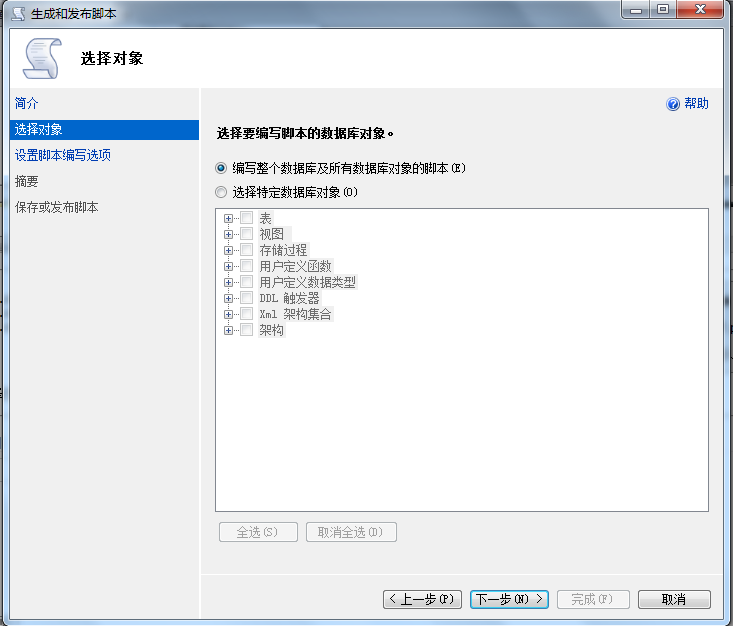
从运行版本10.50.2500(2008R2是10.50)和10.00.1600(2008是10.00)中可以看出这个版本不兼容问题,大部分情况下,从低版本升级到高版本,只要不是跨度太大,如2000升级到2012,都不会怎么报错。除非使用了一些新版本不兼容的特性如*=来实现left join的语句。但是就像上图那样,从高版本还原到低版本的时候,问题就出现了,而且几乎一定会报错。
下面给出几个小建议,例子是从2008 降级到2005:
方法一:使用图形化操作(GUI),打开SSMS(SQL Server Management Studio)
步骤1:右键你要降级的数据库,按下图选择:

步骤2:在对话框中选择:

步骤3:在【高级】中选择下图:

步骤4:把脚本保存起来,然后在SQLServer2005中运行脚本。详细步骤可以看:http://bbs.csdn.net/topics/390438560?page=1#post-394316973 中的13楼的回复,有截图步骤5:通过【任务】→【导入数据】,把数据从2008导入到使用脚本创建的库上如下图,就完成了:

方法二:使用系统自带的存储过程实现:sp_dbcmptlevel ——将某些数据库行为设置为与指定的 SQL Server 版本兼容
下面是其内部实现代码:
SET QUOTED_IDENTIFIER ONSET ANSI_NULLS ONGOcreate procedure sys.sp_dbcmptlevel -- 1997/04/15@dbname sysname = NULL,-- database name to change@new_cmptlevel tinyint = NULL OUTPUT -- the new compatibility level to change toasset nocount on declare @exec_stmt nvarchar(max)declare @returncode intdeclare @comptlevel float(8)declare @dbid int-- dbid of the databasedeclare @dbsid varbinary(85) -- id of the owner of the databasedeclare @orig_cmptlevel tinyint -- original compatibility leveldeclare @input_cmptlevel tinyint -- compatibility level passed in by user,@cmptlvl80 tinyint -- compatibility to SQL Server Version 8.0,@cmptlvl90 tinyint -- compatibility to SQL Server Version 9.0,@cmptlvl100 tinyint -- compatibility to SQL Server Version 10.0select @cmptlvl80 = 80,@cmptlvl90 = 90,@cmptlvl100 = 100 -- SP MUST BE CALLED AT ADHOC LEVEL --if (@@nestlevel > 1)beginraiserror(15432,-1,-1,"sys.sp_dbcmptlevel")return (1)end -- If no @dbname given, just list the valid compatibility level values.if @dbname is nullbeginraiserror (15048, -1, -1, @cmptlvl80, @cmptlvl90, @cmptlvl100)return (0)end -- Verify the database name and get infoselect @dbid = dbid, @dbsid = sid ,@orig_cmptlevel = cmptlevelfrom master.dbo.sysdatabaseswhere name = @dbname -- If @dbname not found, say so and list the databases.if @dbid is nullbeginraiserror(15010,-1,-1,@dbname)print " "select name as "Available databases:"from master.dbo.sysdatabasesreturn (1)end -- Now save the input compatibility level and initialize the return clevel-- to be the current clevelselect @input_cmptlevel = @new_cmptlevelselect @new_cmptlevel = @orig_cmptlevel -- If no clevel was supplied, display and output current level.if @input_cmptlevel is nullbeginraiserror(15054, -1, -1, @orig_cmptlevel)return(0)end -- If invalid clevel given, print usage and return error code-- "usage: sp_dbcmptlevel [dbname [, compatibilitylevel]]"if @input_cmptlevel not in (@cmptlvl80, @cmptlvl90, @cmptlvl100)beginraiserror(15416, -1, -1)print " "raiserror (15048, -1, -1, @cmptlvl80, @cmptlvl90, @cmptlvl100)return (1)end -- Only the SA or the dbo of @dbname can execute the update part-- of this procedure sys.so check.if (not (is_srvrolemember("sysadmin") = 1)) and suser_sid() <> @dbsid-- ALSO ALLOW db_owner ONLY IF DB REQUESTED IS CURRENT DBand (@dbid <> db_id() or is_member("db_owner") <> 1)beginraiserror(15418,-1,-1)return (1)end -- If we"re in a transaction, disallow this since it might make recovery impossible.set implicit_transactions offif @@trancount > 0beginraiserror(15002,-1,-1,"sys.sp_dbcmptlevel")return (1)end set @exec_stmt = "ALTER DATABASE " + quotename(@dbname, "[") + " SET COMPATIBILITY_LEVEL = " + cast(@input_cmptlevel as nvarchar(128)) -- Note: database @dbname may not exist anymoreexec(@exec_stmt) select @new_cmptlevel = @input_cmptlevel return (0) -- sp_dbcmptlevelGO语法
sp_dbcmptlevel [ [ @dbname = ] name ][ , [ @new_cmptlevel = ] version ]参数